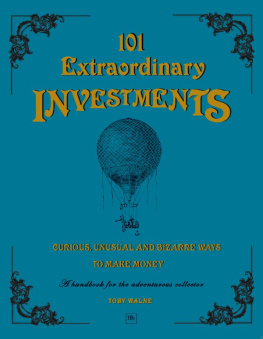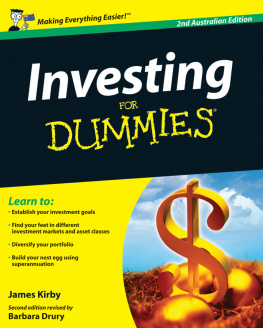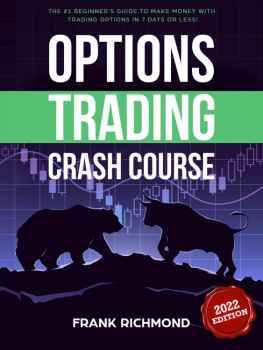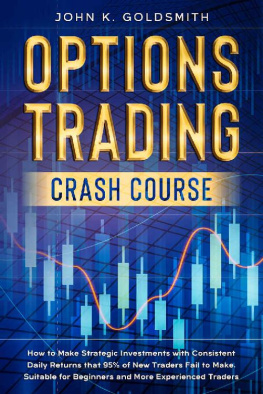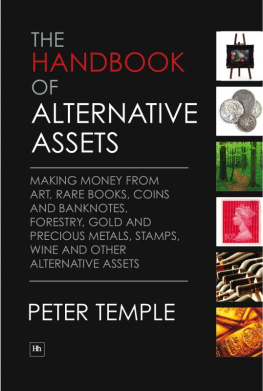Publishing details
HARRIMAN HOUSE LTD
3A Penns Road
Petersfield
Hampshire
GU32 2EW
GREAT BRITAIN
Tel: +44 (0)1730 233870
Fax: +44 (0)1730 233880
Email: enquiries@harriman-house.com
Website: www.harriman-house.com
First published in Great Britain in 2009 by Harriman House. Copyright Harriman House Ltd
This eBook edition 2012
The right of Toby Walne to be identified as the author has been asserted in accordance with the Copyright, Design and Patents Act 1988.
ISBN 978-0-85719-196-0
British Library Cataloguing in Publication Data. A CIP catalogue record for this book can be obtained from the British Library. All rights reserved; no part of this publication may be reproduced, stored in a retrieval system, or transmitted in any form or by any means, electronic, mechanical, photocopying, recording, or otherwise without the prior written permission of the Publisher.
This book may not be lent, resold, hired out or otherwise disposed of by way of trade in any form of binding or cover other than that in which it is published without the prior written consent of the Publisher.
Every effort has been made to obtain permission for the use of all images. Any omissions will be rectified in the next edition.
No responsibility for loss occasioned to any person or corporate body acting or refraining to act as a result of reading material in this book can be accepted by the Publisher, by the Author, or by the employer of the Author.
Sacha, Sophia & Harrison
Introduction
Dr Livingstone, I presume?
Adventurer and journalist Henry Morton Stanley asked this simple question upon discovering the seriously ill explorer on the shores of Lake Tanganyika, in the remote African settlement of Ujiji in October 1871.
Yes, and I feel thankful that I am here to welcome you, came the stiff-upper-lipped response.
The quote is part of the legend of Victorian exploration. Whether it was actually said or not is open to debate. But the spirit of adventure embodied in this event, as well as some remarkable and largely unknown facts surrounding it, certainly mark the inspiration for this book.
It was a golden era of discovery when the sun never set on the British Empire.
Dr David Livingstone had returned from the earlier, ill-fated Zambezi Expedition in 1864. This government-backed trip to Africa had utterly failed in its objective to navigate the fourth-longest river of the Dark Continent. The Scottish former missionary was pilloried for leading such a hopeless quest. His reputation was ruined and a promising career as an explorer seemingly finished.
Yet two years later he was back searching for the source of the Nile.
How on earth was such a feat possible?
Livingstones reputation was destroyed but his business mind was not. He was among the first to realise the great financial rewards open to those who could cater to a new breed of investors who might fund adventurous ideas.
He had returned with a number of curious artefacts, including tribal relics and rare species of orchid. As a fellow of the Royal Geographical Society he enjoyed unprecedented access to other adventurers, scientists as well as financiers men who would also become investors, given the right objects, curios and discoveries to invest in.
Among this closely-knit community in time was the very same Henry Morton Stanley, who not only provided the famous quote but was also the first person to travel the full length of the Congo River. Others included Charles Darwin and fellow African adventurers John Hanning Speke and Richard Francis Burton. In the Edwardian era they were joined by a new generation, including Robert Falcon Scott and Ernest Shackleton.
Exploration funds were often simply raised by trading in curiosities picked up on travels from shrunken heads used as a currency in Papua New Guinea, to African chieftain masks, Amazonian butterflies, and colonial postage stamps.
Unfortunately, because of a rigid code of honour, many of these trades were conducted in secret, within the confines of an inner circle. Few records survive of the various deals undertaken behind the oak-panelled interiors of exclusive gentlemens clubs, tucked away in Londons Mayfair, or carried out in the hallways of mysterious lodges.
What is not commonly known is that this business is still very much alive and thriving today hidden by the very same as well as many other closed doors, with a wide range of modern collectables changing hands along with traditional and unusual curiosities.
Yet times are changing. During this difficult financial climate it seems right to open up to all, at last, the secret world of extraordinary investments. For the world of alternative investments has greatly expanded and greatly altered over time. Although classic artefacts still remain firm favourites, you no longer have to be a prodigiously mustachioed gentleman explorer to participate, or make money, in this game.
With the publishing of this book, many of the modern adventurers who have reaped the benefits to regale their exploits over drinks by a roaring fire occasionally also observed by exotic conquests on the wall may be alarmed.
And the establishment fat cats and financial advisers who profit from our stock market punts and from devilish derivative products in the misguided name of traditional investments should also fear the revelation of each item.
This is because many of these opportunities have been well guarded as secrets.
But be warned. No investment is without risk it is part of the white-knuckle voyage of discovery. The privileged information within this book requires genuine interest and an understanding that values can go down as well as up.
Yet never forget to partake at all times in the derring-do spirit of Victorian adventure. The day belongs to the brave and the bold.
Accept my warmest of welcomes to the inner sanctum of extraordinary investments. I hope you will enjoy the fun and excitement of exploring these many curious and unusual ways to make money.

Action Man
Action Man is making a comeback not just as a toy but also as a shrewd investment.
Nostalgia is feeding the market among grown-up boys who enjoyed Action Man in their childhood and want to go on adventures with him again (or perhaps share the thrills with a younger generation). In the past few years original action figures made from 1966 onwards have typically been rising in value by about 5% a year, with the earliest models now worth as much as 600.
Action Man also has a wardrobe that can be even more collectable than the doll. Among the hundreds of garments, the most valuable is a seventies cricket strip so rare that collectors can pay as much as 6000 for it. Another highly sought after costume is an early Green Beret uniform that can fetch 3000.
Action Man was honourably discharged from duty in 1984 when youngsters started buying Star Wars figures instead, and this has helped push up his collectable value.
He came back in 1996 as a less appealing cartoon-like toy, having undertaken his training at a boot camp run by brain-storming toy salesmen rather than a sergeant major on parade. These later dolls are worthless.
Action Man began life as an American citizen GI Joe in 1964, before emigrating to Britain two years later.
The livid scar on the right cheek is a birthmark. It was not caused by a fighting accident but is a stamp of authenticity. Another quirk is the right hand thumbnail being on the palm side of the thumb on all figures.
Action Man, unlike his imitators, has always had 20 moveable body parts.

